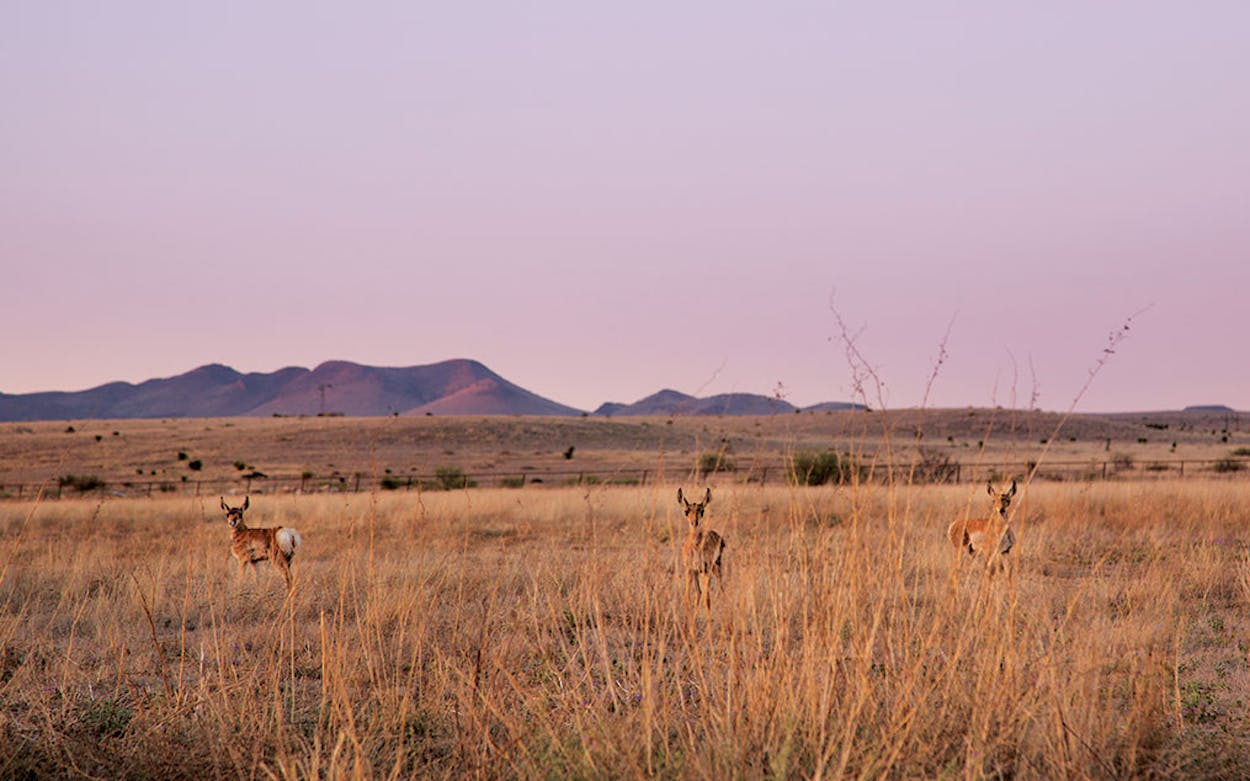The pronghorn buck in my neighbor’s pasture methodically rubbed his jaw on tall stalks of dead careless weed. I’d stopped in the road to watch, out of old habit. The male paid no attention to the idling truck, but the five or six females in his harem flicked their ears toward me before daintily stepping away through the rocks and bear grass.
I’m always happy to see pronghorn. They are handsome creatures, blond and white, with prominent almond-shaped eyes positioned on the sides of their skulls. Unlike any other native North American mammal, pronghorn have elements of both horns and antlers. Males, and some females, sport permanent, hornlike stubs atop their heads, over which the males grow a keratinous black sheath that they shed annually, like antlers. All pronghorn also possess a white patch of fur about the size of an LP that surrounds their tails. When alarmed, that patch stands on end, a signal to others that danger is nigh. But when they flee, pronghorn don’t bound and leap like deer, which they somewhat resemble. Rather, they run flat-out from a threat, their speed their greatest asset. They’re the continent’s fastest land animal, capable of sprinting 45 miles per hour and able to run nearly that fast for miles and miles.
Commonly referred to as pronghorn antelope, pronghorn aren’t antelope at all. They sit on an evolutionary branch all their own, a throwback to 12,000 years ago when lions, cheetahs, and saber-toothed cats roamed North America, preying on pronghorn. “Pronghorn are the only living member of their family left,” says Whitney Gann, a pronghorn researcher with the Borderlands Research Institute at Sul Ross State University, in Alpine. “They’re relics of the Pleistocene Epoch, unique to North America.”
In his book The Great Plains, Texas naturalist Walter Prescott Webb observed that a pronghorn was “the purest type of Plains animal . . . peculiarly well fitted for its chosen environment.” An estimated 35 million pronghorn once ranged over most of the western United States, including two thirds of Texas, and into Canada and Mexico. But by 1915, overhunting and changes in habitat had reduced the U.S. population to about 13,000, prompting a conservation effort that revived the herds, including those in Texas, which by then existed only in the Panhandle and the Trans-Pecos. At their height, in the eighties, Trans-Pecos pronghorn totaled 17,000. By 2012, however, that population had plummeted to a historic low of 2,700, for reasons that weren’t immediately apparent. “When pronghorn are doing well, the grassland is doing well,” Gann says. “When they’re no longer present, that’s an indication something’s really wrong.”
Scientists, landowners, volunteers, and Texas Parks and Wildlife personnel sprang into action. An obvious issue was the lingering drouth that robbed pronghorn and other grazers of food resources. Necropsies of hunter-killed pronghorn also revealed that these Trans-Pecos specimens contained six times as many bloodsucking, anemia-inducing barber pole worms as their Panhandle counterparts. Why did their parasite loads skyrocket?
Fences, mostly. Pronghorn evolved in a vast, open plain. Although they’re capable of jumping, they prefer not to, or it doesn’t occur to them that they can. Consequently, they typically crawl under fences when they encounter them. But net wire fences meant to hold goats or sheep and barbed wire fences with strands low to the ground stymie them. Over time, a lot of West Texas acreage has been cross-fenced into smaller pastures, which has further fragmented the pronghorn’s range. If herds are unable to scramble under a fence, they’ve been known to bottleneck against fence lines, starving, even though there’s good forage just on the other side. “The fences prevented them from moving as they should,” Gann explains. “They ended up depleting their resources and eating where they were defecating. That’s where the worms became an issue.”
To fortify the Trans-Pecos herds, teams over the past six years have captured healthy Panhandle pronghorn, 636 of them, and relocated them to the desert grasslands near Marfa and Marathon. Landowners were educated about the need to provide under-fence corridors; some swapped out fencing types, or allowed Gann and her crew to stretch fences’ bottom wires upward to create crawl spaces. More than 1,500 such modifications have been made. Satellite collars on translocated animals pinpoint where problem spots occur. And the initiatives are working. The most recent census indicates about six thousand pronghorn are now present in the Trans-Pecos. “It’s a good feeling,” Gann says. “We’re trending in the right direction.”
My interest in pronghorn began because of a dog. Years ago, when I first moved to Marfa, jobless, with time on my hands and without much money, my only friend for hundreds of miles was Jip, the red heeler I’d brought with me. Like many of her kind, Jip was unsuitable as a pet and ill-equipped for life in a one-room apartment. Bred to herd cattle, she had the will to stare down a bull and the unquenchable desire to group people and other animals into compact units. Her high-octane intensity called for miles of walking every day. Eventually I won permission to walk her on private property at the edge of town. One evening, we crested a rise on the land’s perimeter and before us was a group of pronghorn, perhaps ten females and a male. The buck saw me first and blew out a snort, flagged his white rump, and raced high-headed with the others toward the fence line. They crowded at the fence, taking turns going under. Jip arrived, eager to goad everyone into an orderly bunch, and the buck looked at the dog, looked at his girls filing under the fence, and then reared up on his hind legs and came down with some force, bonking Jip soundly on the head with his own head. The dazed dog staggered like a character in a cartoon. Once her ears stopped ringing and she could hear me yelling, she yielded to my judgment for the first time in her life and returned to me, her urge to chase pronghorn forever expunged. The pronghorn finished their fence crossing and, the danger clearly neutralized, relaxed and bent their heads to graze once again.
We saw this group almost daily for months. Upon spotting them, we’d stand, sometimes for an hour, Jip hunkered in my shadow, working her nose and reading information on the wind. I didn’t have that sort of insight, but I learned a few things. I learned, for instance, that a sentinel seemed to keep watch while everyone else grazed, napped, or played. When a threat was conveyed, the whole group could be in flight within a heartbeat, never awkwardly bumping into each other even at high speed, able to turn or shift as a group with invisible intelligence.
Walking directly at the herd alarmed them, but they were much less aware of me while I stood still. It was possible to move closer and still hide in plain sight by sliding a foot or two forward when they glanced in the opposite direction. What’s more, they were inquisitive. A pronghorn, when trying to figure me out, would sometimes stamp a front leg, cough, and jerk its head slightly. To see what would happen, I’d make the same sound and gestures. Much staring ensued. In this fashion, the pronghorn would step forward and stop, step forward and stop until it was close enough that I could see the creature blink, appreciate the perfect curve of its ears, and admire the willow slimness of its legs. Invariably, in the midst of this dreamy, slow-motion mutual examination, Jip would scratch an ear, stand up, or otherwise shift around. Our reverie dissolved. The pronghorn zeroed in on the reality of the human and dog before it and streaked to its herd mates as smooth and sure as a speeding arrow.
Much later, I felt vindicated while reading Webb’s comments on “antelopes.” “With the antelope, curiosity and caution are strangely mingled,” he wrote. “Hunters could draw antelope within range by firing guns. The animals were attracted by the dust made by the bullet striking the ground, but paid no attention to the sound of the gun. They were ruled by sight and curiosity.”
My red heeler is long gone, but the pronghorn remain. Often they’ll trickle from the neighbor’s hill to our pasture, before wandering east, toward the golf course, and back again. Once, during a purple sunset, my son and I sat horseback and watched a young interloper from a band of bachelors sneak into the harem of an established buck. The buck bolted for him and chased the interloper in relentless circles around us, around the harem, around the pasture, the interloper bleating a rhythmic mer, mer, mer as it sped crazily from its aggressor. We’ve seen a lone pronghorn buck blast past our place headed east until it was out of sight, running full tilt to or from something unseen and unknown. We’ve seen does lying at rest together, legs folded as neatly as clasped hands, chewing their cuds in companionable quiet. A doe sporting ear tags and a radio collar—one of the Panhandle transplants—drank from our trough one afternoon while we fed chickens. And just now, from the vantage of the barn’s back door, I saw a pronghorn doe glide under the pipe fence and pause. From the spot where she had hidden it amid the grass, her baby rose on skyscraper legs, wobbled for an instant, and then walked steadily to its mother.








